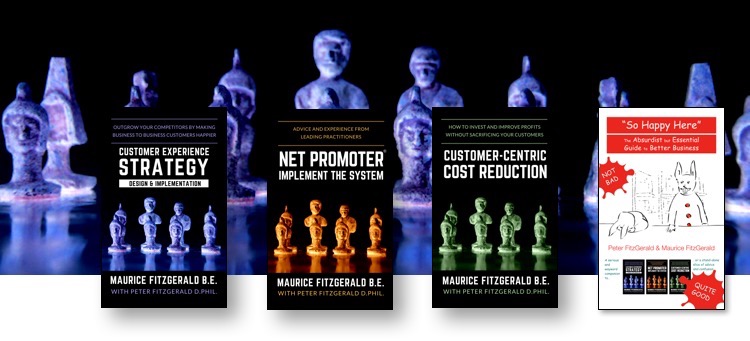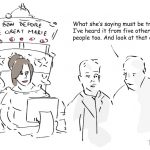#87 – Reverse-engineering CX, Customer-employee NPS, CCXP exam questions, your personal promise to customers
 Let’s reverse-engineer customer experience. How about asking your employees what you should improve for customers? Welcome to the 87th edition of my customer strategy newsletter. The five topics this week are:
Reverse engineer customer experience improvementsAs you may have seen in my blog post about customer-centric business strategy (see below), I have become intensely irritated by my observation that most companies seem far more interested in measuring satisfaction than improving it. The core work of customer experience people should be the implementation of improvements. Measurements should support this work, but they are not what customer experience leadership is about. Today, most of the work done by customer experience professionals is about measurement and reporting. While individual business and functional teams may get relevant information and work on their own improvements, this leaves a huge gap: Cross-business, cross-functional improvement work simply does not happen at all. I believe there is a better way. Let me go further: I believe there is a better way to approach customer experience improvement work than any current methodology used by any company on the planet. My thinking on this is driven by a sales course I took in 1996. It was given by the husband-and-wife team of Mary and Michael Molloy and the book that accompanied it is called The Buck Stops Here. The principle was that you set up the sales process from the end, then worked backwards to put everything in place that you need to win. And only what you need. Applying the principle to company-wide customer experience work would look like this:
The message to your teams would be simple: our customer-centric improvement work will be driven by specific research that will always result in improvement projects. There will be no customer research done simply to measure people. You have operational metrics for that, and don’t need to bother customers with it. What do you think? (I feel a book coming on.) How about implementing Customer-Employee NPS?Continuing one of the points made above, while customers are the best source of improvement suggestions, there is no reason they should be the only source. Why not ask your employees? On top of costing far less than customer research, you will get them engaged in improvement work and are likely to get enthusiastic volunteers. Employees may have insights in areas that would not naturally occur to customers. One example that springs to mind happened shortly after HP set up a centralized pre-sales group in Bucharest, Romania. When the new operation started up, it would be fair to say that the people were quite passive, just doing what was asked. Sales people and resellers asked them to provide price quotations to customers, and they did that work well. Then the team supporting the Benelux noticed something. As negotiation cycles continued, sales people removed things from orders to meet a customer price point. Notably, offers for servers and storage that started with round-the-clock support services were often reduced to a cheaper business-hours-only proposal. The Benelux team in Bucharest decided to systematically give the customers two proposals: one exactly as requested, and one with the service levels they believed the customers really needed, at a higher price. The initiative was a great success, with about half the customers taking the more appropriate service proposal at the higher price. For customers who accepted, it completely eliminated the situations where they would call during a weekend to be told that their contract did not cover the repair. A customer would never have thought of this double-proposal idea. Using Net Promoter System methodology, a ceNPS feedback request would go to all of your employees and look like this:
Please let me know what you think. If I could have come up with a word that started with ‘A’ for the name, I would have called it ‘aceNPS‘, which would have been nice. Our latest blog postsOlder posts are still available on the blog page.
Notable customer experience items from other sitesShep Hyken – Your personal promise to your customersShep always has some nice cartoons in his blog posts. His main content is about healthcare this time, though the message has far wider implications. Shep uses Dr. Neil Baum’s ten personal promises to his patients as an example for us all. I have to say that caring for elderly relatives means that I come into increasing contact with different parts of the (excellent) Swiss healthcare system. I think most doctors and clinics could benefit from a set of promises like these. It’s about a four-minute read here. Omnitouch/Daniel Ord – 10 sample questions for the CCXP examI am a member of the Customer Experience Professionals Association (CXPA). The association offers one of the few recognized customer experience exams, which results in Certified Customer Experience Professional accreditation. There are six areas involved. Daniel Ord has posted sample questions in two of the areas. The set I suggest looking at first is about customer experience strategy. Test your knowledge here. Looking forwardTwo big things will be happening over the next seven weeks. As soon as the American Customer Satisfaction Index people publish their report for retail, I will be able to complete the data analysis work for my annual study of the relationship between employee and customer satisfaction. And I am also pleased to say that I will be speaking at the CustomerGauge Monetize! event in Amsterdam. I will probably be on stage on March 13th, and expect to stay over to the 14th. I hope to meet some readers there. The event website is here. January book sales are going well. Thank you. Here are links to all of our books on Amazon.com. Kindle versions are available in all stores. Print versions are available from the major stores only. If you have already read any of our books, please write reviews on Amazon. Customer Experience Strategy – Design & Implementation Net Promoter – Implement the System Customer-centric Cost Reduction “So Happy Here”: The Absurdist but Essential Guide to Better Business (Color edition) “So Happy Here”: The Absurdist but Essential Guide to Better Business (Black & White edition) Please share this newsletter with your friends and colleagues and encourage them to sign up for it here. I have put links to past newsletters on the subscription page. Finally, please feel free to change or cancel your subscription using the link below. You can also email me, Maurice FitzGerald, at mfg@customerstrategy.net. |
|||||||
|
|






